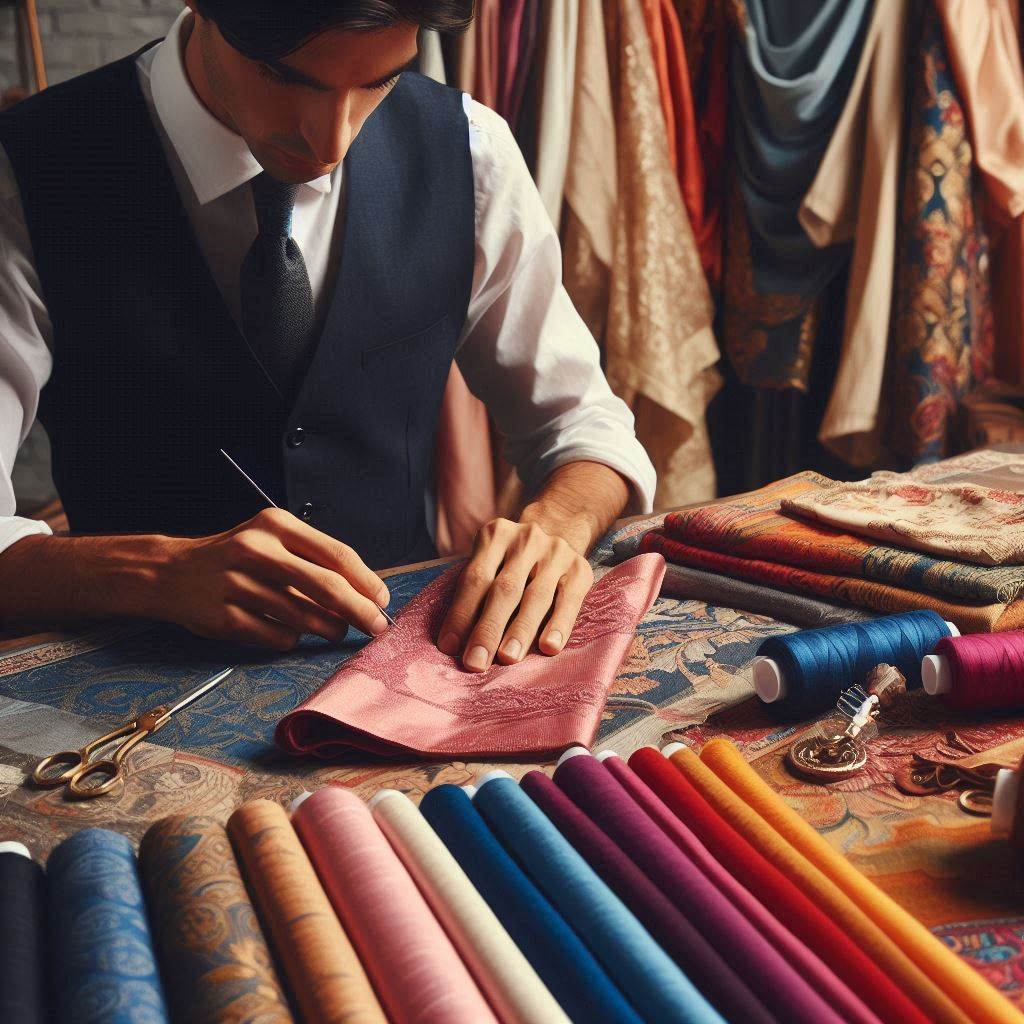Introduction
Understanding fabrics in costume design is essential for creating visually striking and authentic costumes.
Fabrics determine the texture, flow, and movement of a garment, which can significantly impact the overall look of a costume.
Different fabrics evoke different emotions and enhance the character’s portrayal on stage or screen.
Fabrics play a crucial role in defining:
- Silhouette: Heavier fabrics like wool create structure, while lighter fabrics like chiffon provide fluidity.
- Color: Fabrics absorb and reflect light differently, affecting the appearance under stage lighting.
- Comfort: Breathable fabrics like cotton ensure comfort during long performances.
Choosing the right fabric is critical in costume design.
It helps bring the character to life by aligning the costume with the personality, time period, and context of the role.
A stiff fabric might communicate authority, while a flowing material could signify grace or freedom.
Costume designers must select fabrics that not only look good but also support the actor‘s movement and performance.
The Role of Fabric in Costume Design
When it comes to costume design, fabric choice plays a crucial role in bringing a character to life on screen or stage.
The type of fabric selected can convey a character’s personality, status, and the time period in which they exist.
Conveying Character’s Personality, Status, and Time Period
Rich fabrics like silk or velvet can suggest wealth and sophistication, while simpler fabrics like linen or cotton may indicate a more down-to-earth character.
The choice of historical fabrics such as brocade or damask can help place a character in a specific time period, whether it’s the Elizabethan era or the Roaring Twenties.
Fabric textures like rough burlap or smooth satin can also reveal aspects of a character’s personality, such as ruggedness or elegance.
Draping, Movement, and Light Reflection
Aside from conveying character traits, different fabrics also have unique properties that affect how they drape, move, and reflect light.
Lightweight fabrics like chiffon or organza flow gracefully with movement, creating a sense of elegance and fluidity on screen.
Heavier fabrics like wool or tweed drape more stiffly, adding weight and structure to a costume, which can be suitable for characters with authority.
Fabrics with a shiny surface like satin or sequins reflect light, creating a glamorous effect that can enhance a character’s presence on stage or screen.
Texture, Color, and Pattern
While fabric choice is key, texture, color, and pattern also play significant roles in costume design.
Textured fabrics like lace or fur can add depth and visual interest to a costume, making it more visually engaging for the audience.
Color can evoke specific emotions or signify cultural meanings, with red representing passion or danger, while blue conveys trust and tranquility.
Transform Your Career Today
Unlock a personalized career strategy that drives real results. Get tailored advice and a roadmap designed just for you.
Start NowPatterns like stripes or florals can help define a character’s personality traits, such as boldness or femininity, and can be used to create visual contrast or harmony within a costume.
Overall, fabric selection in costume design involves a careful consideration of not just the type of fabric but also how it drapes, moves, reflects light, and interacts with texture, color, and pattern.
By understanding how fabric choices influence the overall look and feel of a costume, costume designers can create more nuanced and impactful characters that resonate with audiences.
Read: How to Balance Creativity and Practicality
Types of Fabrics Commonly Used in Costume Design
Natural Fabrics
- Cotton: Known for its breathability and comfort, perfect for everyday costumes.
- Silk: Luxurious and smooth fabric, often used for elegant and formal costumes.
- Wool: Provides warmth and insulation, great for costumes in cold climates.
- Linen: Lightweight and durable, ideal for costumes in hot weather.
Synthetic Fabrics
- Polyester: Wrinkle-resistant and easy to care for, suitable for budget-friendly costumes.
- Nylon: Strong and durable, commonly used in athletic or performance costumes.
- Spandex: Known for its stretchiness and elasticity, ideal for form-fitting costumes.
Blending Fabrics
Benefits
- Enhanced durability and strength
- Improved fit and comfort
- Cost-effective compared to using solely natural or synthetic fabrics
Cons
- Potential for shrinkage or stretching if not blended correctly
- Color may fade differently on each fabric type
- Requires careful care instructions to maintain fabric integrity
Understanding the characteristics and benefits of different types of fabrics in costume design is crucial for creating costumes that not only look great but also serve their purpose effectively.
Whether you’re working on a historical period piece or a futuristic sci-fi project, choosing the right fabrics can make all the difference in the final outcome.
By exploring the world of natural and synthetic fabrics, as well as the advantages and disadvantages of blending different types of fabrics, costume designers can elevate their work to new heights.
Read: How to Start a Career as a Digital Artist
Considerations when Choosing Fabrics
When designing costumes for a production, it is crucial to consider various factors that will impact the overall outcome.
Here are some key considerations to keep in mind:
Importance of Durability, Comfort, and Washability
Choosing durable fabrics is essential to ensure that costumes withstand the wear and tear of performances.
Comfort is vital for actors to move freely and perform without feeling restricted by their attire.
Washability is necessary for maintaining the cleanliness and freshness of costumes throughout the production.
Impact of Fabric Weight and Thickness
Fabric weight and thickness can significantly influence the look and function of a costume.
Lightweight fabrics are ideal for creating flowy and ethereal costumes, while heavy fabrics can add structure and volume.
The thickness of the fabric also affects how it drapes and retains its shape on the body.
Considering the Setting and Context of a Production
The setting and context of a production play a crucial role in determining the appropriate fabrics to use.
For period pieces, historical accuracy may require specific fabrics that were prevalent during that time period.
Contemporary productions may call for more modern fabrics that align with the aesthetic of the setting.
Showcase Your Business Today
Reach thousands of readers actively exploring professional services. Publish your business profile and grow your audience now.
Publish NowBy taking these considerations into account, costume designers can create costumes that not only look visually appealing but also serve the practical needs of the production.
Selecting the right fabrics is a crucial step in bringing characters to life on stage or screen.
Read: Trends in Art and Design Education Curriculum

Fabric Manipulation Techniques in Costume Design
Fabric manipulation plays a crucial role in costume design, adding texture, depth, and character to garments.
Designers use various techniques to achieve unique looks.
Here are some popular fabric manipulation methods and their effects.
Dyeing, Painting, and Printing Techniques
- Dyeing: Changing the fabric’s color by submerging it in dye baths. Designers create ombr‘ effects, bold hues, or subtle tones.
- Painting: Hand-painting designs directly onto fabric. It allows for detailed, customized patterns and artistic touches.
- Printing: Applying patterns onto fabrics using methods like screen printing or block printing. It adds consistent designs and repeated motifs.
- Distressing: Intentionally aging or roughening fabric to create a worn, vintage look. Common methods include sandpapering or bleach spots.
Textural Manipulation: Pleating, Ruching, and Gathering
- Pleating: Creating folded patterns on fabric. Pleats give structure and movement to costumes.
- Ruching: Gathering fabric in a repeated pattern for added volume. It creates a flowing, elegant effect.
- Gathering: Pulling the fabric together to create fullness. Gathering adds dimension and helps shape the silhouette.
- Smocking: Embroidering tightly gathered fabric to create textured, flexible panels.
Importance of Understanding Fabric Response
Understanding how different fabrics react to these techniques is vital.
For instance:
- Silk holds dye beautifully but can tear under stress.
- Cotton gathers well but may look stiff when pleated.
- Polyester resists dyeing and printing but works well for pleating.
Each fabric behaves uniquely under manipulation.
A skilled designer tailors their techniques based on the fabric’s natural properties.
This knowledge ensures the garment achieves the desired look while maintaining quality.
Mastering fabric manipulation adds a creative edge to costume design, elevating a simple fabric into an artistic masterpiece.
Read: Developing Storytelling Through Costumes
Find Out More: Understanding Concept Art Styles and Techniques
Sustainable and Ethical Fabric Choices
Sustainable and ethical fabric choices are gaining popularity in costume design.
Designers now prioritize eco-friendly options, considering their environmental impact.
This shift reflects the growing awareness of sustainability and responsible consumption.
Why Choose Sustainable Fabrics?
Environmental Responsibility
Using sustainable fabrics reduces the harmful effects of conventional textile production.
Eco-friendly options require fewer resources and produce less waste, helping to minimize the environmental footprint of costume design.
Ethical Sourcing
It’s essential to choose fabrics that are ethically sourced.
Ethical practices ensure fair wages and safe working conditions for workers in textile production, contributing to better social outcomes globally.
Reducing Waste
Sustainable fabrics can be recycled or composted, reducing landfill waste.
Designers increasingly look for materials with a second life, lowering their overall environmental impact.
Sustainable Fabric Options
Organic Cotton
Organic cotton uses fewer chemicals, pesticides, and water than conventional cotton.
It provides a soft, durable, and versatile option for costume designers while being kinder to the environment.
Bamboo Fabric
Bamboo is fast-growing, requiring minimal water and no pesticides.
Its fibers create a soft, breathable fabric that is both eco-friendly and renewable.
Recycled Polyester
Recycled polyester gives new life to plastic waste, turning it into fabric.
This option reduces plastic pollution while offering a durable, lightweight material suitable for costume design.
The Importance of Ethical Production Practices
When choosing fabrics, it’s crucial to consider the ethics behind production.
Always look for certifications such as Fair Trade, Global Organic Textile Standard (GOTS), and OEKO-TEX, which ensure both environmental sustainability and worker welfare.
Ethical fabric choices reflect a commitment to both quality and conscience.
By embracing sustainable and ethical fabrics, costume designers can create stunning designs while contributing positively to the planet.
These choices reflect not just aesthetic considerations, but also a growing sense of responsibility.
Care and Maintenance of Costume Fabrics
Proper care and maintenance of costume fabrics are essential to ensure their longevity and appearance on stage.
Below are some tips for caring for and storing costume fabrics:
Properly Caring for Costume Fabrics
- Follow care instructions provided by the fabric manufacturer to avoid damaging the fabric.
- Avoid using harsh chemicals or bleach when washing costume fabrics.
- Hand wash delicate fabrics and air dry them to prevent shrinking or stretching.
- Store fabrics in a cool, dry place away from direct sunlight to prevent fading.
- Invest in fabric protectors to prevent stains and spills on costume fabrics.
Importance of Following Care Instructions
- Following care instructions provided by fabric manufacturers is crucial for maintaining the quality of the fabric.
- Ignoring care instructions can lead to color fading, shrinking, or damage to the fabric fibers.
- Proper care ensures that the fabric retains its original look and feel for multiple uses.
- Following care instructions also helps in preserving the vibrant colors of the fabric over time.
Benefits of Having a Designated Wardrobe Team
- A designated wardrobe team can handle costume maintenance during productions, saving time and effort.
- Wardrobe teams are trained to follow care instructions and know how to handle different types of fabrics.
- Having a dedicated team ensures that costumes are always in top condition for performances.
- Wardrobe teams can identify and address any issues with costume fabrics promptly to prevent further damage.
By following these tips and guidelines for caring for costume fabrics, designers and production teams can ensure that their costumes look their best on stage and last for multiple performances.
You Might Also Like: Interactive Media Design: Daily Work Routine
Conclusion
In costume design, fabric choice is vital for character portrayal.
Different fabrics can convey specific emotions and themes.
Showcase Your Business Today
Reach thousands of readers actively exploring professional services. Publish your business profile and grow your audience now.
Publish NowFor example, silk can create a sense of elegance and luxury.
While rough textures like burlap can suggest ruggedness or poverty.
It’s important to consider both the visual and tactile aspects.
The weight, drape, and color of a fabric can impact the overall look.
Be mindful of historical accuracy when selecting fabrics.
Research the time period and social status of your characters.
Experimenting with different fabrics can enhance creativity and authenticity.
Ultimately, fabric selection can bring characters to life on stage.
Remember, the success of a costume design depends greatly on fabric choices.
Encourage readers to explore fabric options and their effects.
Fabric selection is a crucial element in costume design.
[E-Books for Sale]
The Big Book of 500 High-Paying Jobs in America: Unlock Your Earning Potential
$19.99 • 500 High-Paying Jobs • 330 pages
Explore 500 high-paying jobs in America and learn how to boost your career, earn more, and achieve success!
See All 500 High-Paying Jobs of this E-Book
1001 Professions Without a Degree: High-Paying American Jobs You Can Start Now
$19.99 • 1001 Professions Without a Degree • 174 pages
Discover 1001 high-paying jobs without a degree! Unlock career tips, skills, and success strategies for just $19.99!




